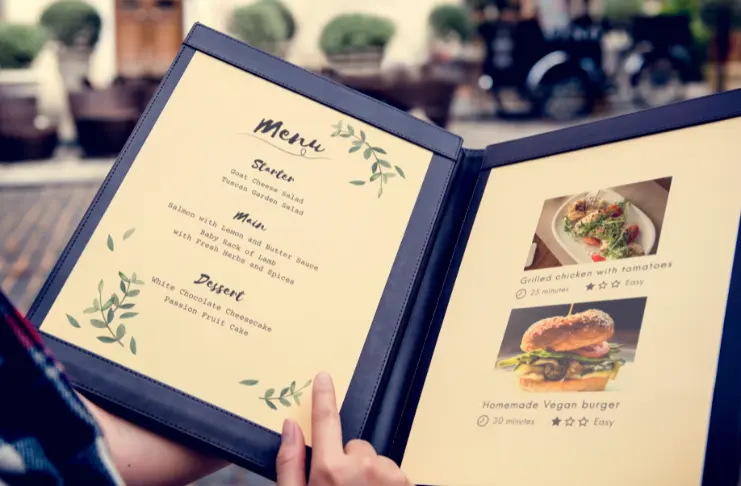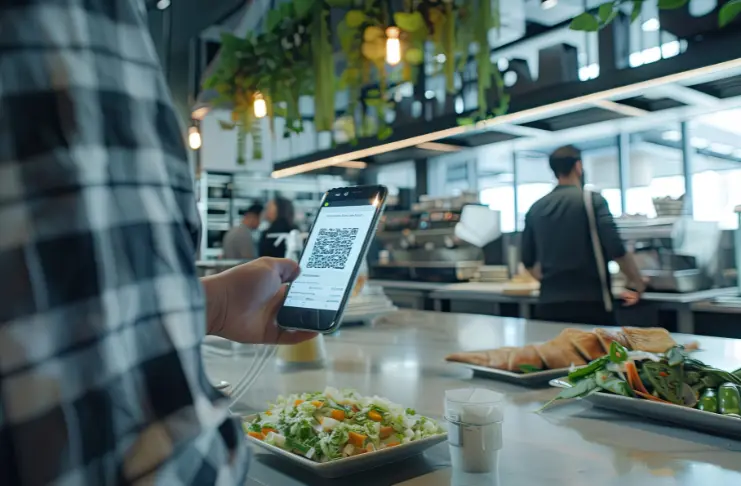When it comes to crafting a successful menu engineering plan, one of the most impactful decisions is its size. The small vs big restaurant menu debate is more than just a question of how many dishes to offer—it’s a strategic choice that can make or break your profitability and overall restaurant performance. From operational efficiency to customer satisfaction, the size of your menu influences virtually every facet of your business.
In recent years, restaurant owners have faced increasing pressure to balance variety with quality to build a profitable restaurant. While large menus can appeal to a broader audience by providing extensive options, they often bring challenges such as higher food costs, ingredient waste, and slower kitchen workflows. On the other hand, smaller, curated menus allow for tighter control over ingredients and staff training, often translating to better consistency and faster service, helping to feature more profitable items.
This comprehensive restaurant menu strategy comparison will help you understand how menu size affects restaurant performance and profitability. By analyzing the pros and cons of both approaches using a menu matrix, you’ll gain insights into the best menu size for restaurant profitability tailored to your unique business goals and customer base.
Whether you’re considering trimming your menu or expanding it to attract more diners, this guide will equip you with the knowledge needed to make an informed, data-driven decision that not only enhances both your bottom line and guest experience but also encourage customers to try new offerings.
Understanding Restaurant Menu Strategy Comparison

Choosing the right menu size is a pivotal decision for any restaurant owner. The ongoing small vs big restaurant menu debate goes far beyond just the number of items offered—it directly impacts profitability, customer satisfaction, and operational efficiency.
Understanding how menu size affects restaurant performance helps restaurateurs craft the best menu strategy for their unique goals. Here’s a breakdown of key factors in the restaurant menu strategy comparison:
- Small menus (typically 15-30 items) streamline kitchen processes, simplify ingredient sourcing, and reduce staff training time. Larger menus (50-100+ items) demand more diverse inventory and complex workflows, which can increase costs and slow service.
- Extensive menus can overwhelm diners, causing decision fatigue and longer ordering times, while smaller menus focus customer attention, guiding them toward signature dishes and boosting satisfaction. The right balance impacts perceived value and brand positioning.
- Modern diners increasingly favor quality over quantity, with many seeking authentic, well-prepared dishes rather than overwhelming variety. This shift favors smaller, focused menus that adapt quickly to dietary trends and supply chain changes.
- Restaurants with curated menus often see higher profitability due to better cost control and the ability to highlight high-margin items. Conversely, big menus can attract a broader customer base but risk inefficiencies and waste if not managed carefully.
Finding the best menu size for restaurant profitability requires a strategic balance that aligns with your brand, target market, and operational capabilities. Whether you opt for a small, focused menu or a larger, diverse selection, understanding how menu size affects restaurant performance is essential to crafting a winning restaurant menu strategy.
Ultimately, success comes from tailoring your menu to deliver exceptional dining experiences while optimizing efficiency and profit.
Small Restaurant Menu Strategic Advantages

Smaller menus offer distinct advantages for restaurants focused on operational efficiency, quality, and strong brand identity through carefully selected food items.
Operational Efficiency and Cost Control
Smaller menus streamline operations, making them a strategic choice in the small vs big restaurant menu debate. Some benefits of smaller menus are:
- Simplifies kitchen operations with fewer recipes, boosting consistency and reducing prep time.
- Eases inventory management and enables bulk purchasing, which supports better supplier negotiations.
- Lowers food waste while increasing profit margins—key for the best menu size for restaurant profitability.
- Reduces staff training time and costs, enhancing team efficiency in high-turnover environments.
For restaurants seeking sustainable growth, smaller menus offer a lean and performance-driven strategy that directly impacts restaurant profits by balancing popularity and profitability.
Quality Focus and Brand Consistency
By narrowing down their offerings, restaurants gain a powerful edge in food quality and profit margin —a compelling argument in the small vs big restaurant menu debate. Some advantages of this focus include:
- Enhanced recipe consistency and quality through repeated preparation and fine-tuning.
- Strengthened customer trust and loyalty thanks to dependable flavor and presentation.
- Better purchasing power on quality ingredients, boosting both taste and profitability.
- Higher perceived value that supports premium pricing is key to restaurant menu strategy comparison.
In a competitive market, focusing on fewer, high-quality items based on sales data can be the cornerstone of culinary excellence and customer retention.
Market Positioning and Brand Identity
Small menus help restaurants stand out by reinforcing a clear and memorable brand identity. Some branding benefits of this approach include:
- Clarifies your restaurant’s strengths, making it easier for customers to form expectations.
- Supports niche positioning that attracts loyal audiences and enables premium pricing.
- Enhances authenticity, a key factor in today’s restaurant menu strategy comparison.
- Boosts word-of-mouth marketing by making standout items easier to recommend.
When it comes to building a recognizable brand in the restaurant business, a focused menu can speak louder than any ad campaign, especially when paired with effective visual cues.
INDUSTRY INSIGHT
| According to US Foods, 79% of Americans find it difficult to decide what to order. This emphasizes how large menus overwhelm customers and smaller, focused menus that reduce decision fatigue |
By streamlining offerings, restaurants can boost consistency, enhance customer loyalty, and create a clear, memorable brand that drives long-term success.
Big Restaurant Menu Strategic Benefits

Large menus provide restaurants with the flexibility and variety needed to meet diverse customer preferences and drive growth across multiple dining occasions.
Customer Satisfaction Through Variety
Large restaurant menus offer broad appeal by satisfying a wide range of tastes and needs in one setting. According to Technomic, 30% of consumers at coffee-café brands and 28% at fast-casual outlets want more items on the menu. Some advantages of this expansive approach include:
- Appeals to families and groups with mixed preferences, boosting customer inclusivity.
- Attracts business diners seeking variety for different dietary needs and preferences.
- Supports seasonal specials and rotating items, keeping the menu fresh year-round.
- Plays a strategic role in how menu size affects restaurant performance and traffic flow.
When managed well, a large menu can serve as a growth engine by maximizing group satisfaction and visit frequency.
Revenue Generation and Market Capture
Menus with multiple categories enable restaurants to diversify their offerings and revenue sources throughout the day. Some strategic benefits of this approach include:
- Targets different dining occasions—breakfast, lunch, and dinner—under one roof.
- Offers varied price points to appeal to both budget-conscious and premium diners.
- Increases average check size through upselling beverages, desserts, and pairings.
- Enhances the best menu size for restaurant profitability by maximizing per-guest revenue.
When designed thoughtfully, a multi-category menu becomes a powerful tool for capturing wider demand and driving sales across dayparts.
Adaptability and Trend Response
Large menus offer restaurants the flexibility to innovate and adapt in fast-changing food markets. Some key benefits of this adaptability include:
- Enables testing of new dishes and trends without disrupting core menu favorites.
- Accommodates diverse dietary needs like vegetarian, vegan, and gluten-free options.
- Addresses regional tastes by combining local specialties with popular classics.
- Supports a dynamic restaurant menu strategy comparison focused on customer inclusivity.
By embracing menu flexibility, restaurants can stay relevant and appeal to a broader, evolving customer base through strategic menu engineering .
When carefully managed, extensive menus can boost customer satisfaction and help set the ideal menu price, increase revenue, and keep restaurants agile in a rapidly changing market.
How Menu Size Affects Restaurant Performance

Menu size directly influences kitchen operations, service speed, and financial performance, making it a critical factor in a restaurant’s overall success.
Kitchen Operations and Workflow Impact
Menu size plays a crucial role in shaping kitchen workflow and overall staff productivity. Some important insights include:
- Small menus streamline preparation by using overlapping ingredients, speeding up service.
- Large menus increase complexity, requiring more prep time and diverse skills, which can raise labor costs.
- Moderate menu sizes often strike the best balance between variety and kitchen efficiency.
- Understanding how menu size affects restaurant performance is essential for operational success.
Optimizing your menu size to fit your kitchen’s strengths can dramatically improve both speed and quality in food service.
Service Speed and Customer Experience
Service speed is closely tied to how complex and large a restaurant’s menu is. Some key points to consider include:
- Smaller menus lead to quicker ordering and faster food preparation, boosting table turnover.
- Larger menus can slow decision-making but offer more choices to satisfy diverse customer needs.
- Effective menu design and staff training are crucial to maintaining service speed regardless of menu size.
- Technology like digital menus can streamline ordering and improve overall efficiency.
Balancing menu size with smart design and tools helps restaurants enhance guest experience while maximizing profitability.
Financial Performance Metrics
Food and labor costs are deeply influenced by menu size, impacting overall restaurant profitability. Key points include:
- Small menus reduce food costs through bulk buying and minimizing waste.
- Labor costs are lower with small menus due to streamlined training and prep.
- Large menus may increase costs, but they can raise the average check size with diverse options.
- Profit margins are often stronger on focused menus that optimize ingredient use and efficiency.
Understanding these cost dynamics is essential when deciding the best menu size for restaurant profitability.
By carefully balancing menu size with operational capabilities and financial goals, including how to price menu items, restaurants can enhance efficiency, improve customer experience, and boost profitability.
Best Menu Size for Restaurant Profitability

Menu size plays a vital role in shaping a restaurant’s profitability, with both small and large menus offering distinct financial advantages.
Small Menu Profitability Analysis
Small restaurant menus often outperform larger ones by boosting profitability through streamlined operations. Some reasons as to why include:
- Reduced food costs from bulk purchasing and less waste due to fewer ingredients.
- Increased labor efficiency as staff master a focused set of dishes, lowering prep and training time.
- Higher profit margins by perfecting select dishes and using premium ingredients effectively.
- Aligns with the best menu size for restaurant profitability by balancing quality and cost control.
For restaurants aiming to maximize profits, smaller menus offer a clear operational and financial advantage.
Large Menu Revenue Optimization
Extensive menus can drive higher revenue by offering diverse choices and price points, a key factor in the discussion of small vs. big restaurant menus. Some benefits include:
- Increased average check size through appetizers, entrees, desserts, and beverage options.
- Broader market appeal by catering to varied tastes and dietary needs.
- Enhanced cross-selling opportunities with thoughtful menu pairings and promotions.
- Supports strategies focused on the best menu size for restaurant profitability by maximizing spend per visit.
When leveraged effectively, large menus can boost revenue and create richer dining experiences that keep customers coming back.
Finding the Optimal Balance
Finding the best menu size for restaurant profitability means balancing variety and efficiency—a core topic in the small vs big restaurant menu debate. Some key strategies include:
- Offering enough options to meet customer preferences without overwhelming operations.
- Using market research and customer feedback to fine-tune menu size and offerings.
- Testing new menu configurations with seasonal or limited-time items to gauge success.
- Emphasizing data-driven decisions to improve how menu size affects restaurant performance.
By continuously refining menu size, restaurants can maximize profitability while keeping customers satisfied and operations smooth.
Striking the right balance between variety and efficiency, guided by customer insights and operational data, helps restaurants optimize their menu size for sustained profitability and growth.
Cost Analysis and Financial Planning

When deciding between small and large menus, understanding the direct and hidden costs involved is essential for maximizing restaurant profitability.
Direct Cost Comparison Factors
Food, labor, and equipment costs, including the food cost percentage, are key factors in the discussion of small vs. big restaurant menus, which directly influence profitability. Important considerations include:
- Small menus reduce food costs through bulk buying and less ingredient variety.
- Labor expenses are lower with small menus due to simpler prep and shorter training.
- Large menus may require specialized equipment and more complex kitchen infrastructure.
- Balancing these costs is vital when determining the best menu size for restaurant profitability.
Understanding how menu psychology and menu size affects restaurant performance helps owners optimize both operational efficiency and cost management, especially during a menu redesign .
Hidden Costs and Investment Planning
Inventory, training, and quality control costs rise with increasing menu size, affecting overall restaurant profitability. Key points to consider include:
- Larger menus increase inventory carrying costs due to more ingredients and storage needs.
- Training expenses grow as staff must learn and maintain knowledge of a wider variety of dishes.
- Quality control becomes more complex and costly with diverse menu offerings.
- Managing these hidden costs is crucial for identifying the best menu size for restaurant profitability.
By carefully controlling these factors, restaurants can improve how menu size affects restaurant performance and sustain long-term success.
Return on Investment Strategies
Small vs big restaurant menu decisions greatly impact investment returns and financial planning. Some essential points include:
- Small menus often enable quicker return on investment due to simpler operations and lower startup costs.
- Large menus may take longer to break even, but offer greater potential for long-term revenue growth.
- Careful cash flow management and patience are necessary when investing in extensive menu options.
- Break-even analysis and financial modeling are key tools for choosing the best menu size for restaurant profitability.
Thoughtful financial planning ensures that the menu strategy aligns with both short-term goals and sustainable growth.
By carefully managing food, labor, training, and quality control expenses—and aligning investment plans with operational realities—restaurants can choose the optimal menu size to balance efficiency, customer satisfaction, and long-term financial success.
Customer Experience and Satisfaction Factors

Understanding how menu size influences customer psychology and social dynamics is key to crafting a dining experience that drives satisfaction and profitability.
Decision-Making Psychology and Choice Architecture
Menu psychology plays a vital role in how small vs big restaurant menu sizes affect customer behavior and is crucial in restaurant menu design. Some important insights include:
- Excessive choices on large menus can cause decision paralysis and slow ordering.
- Smaller menus reduce cognitive load, making it easier and faster for customers to decide.
- Thoughtful menu design and choice architecture guide customers toward high-value items.
- Leveraging menu psychology is essential for optimizing how menu size affects restaurant performance.
By combining smart menu size with effective design, restaurants can enhance customer satisfaction and boost profitability.
Satisfaction and Expectation Management
Customer satisfaction is deeply influenced by menu size and quality, a crucial factor in the small vs big restaurant menu debate. The key points include:
- Small menus that focus on quality can exceed customer expectations and build loyalty.
- Large menus offer variety but risk inconsistent quality, potentially lowering satisfaction.
- Repeat visits may be higher with small menus as customers explore all offerings over time.
- Thoughtful accommodation of dietary needs is important regardless of menu size.
Ultimately, customer satisfaction depends on how well the menu aligns with expectations and delivers consistent, enjoyable dining experiences.
Social Dining and Group Considerations
Group dining and special occasions, particularly in family-style restaurants, often influence the decision to choose between small and big restaurant menus. Important considerations include:
- Larger menus accommodate diverse tastes within families and business groups, boosting group visits.
- Extensive options enhance special occasion dining by offering choice and customization.
- Cultural preferences affect menu size expectations, varying by community and customer base.
- Tailoring menu sizes to group dynamics and cultural contexts supports the best menu sizes for restaurant profitability.
By aligning menu strategy with social and cultural needs, restaurants can attract more diverse customer segments and increase revenue.
By leveraging menu psychology, managing expectations, and catering to group preferences, restaurants can optimize their menu size to enhance customer experience, encourage repeat visits, and boost overall performance.
Staff Training and Operational Management

Staff training and kitchen workflow are crucial elements that shape how menu size impacts restaurant operations and profitability.
Training Complexity and Implementation
Staff training is a critical factor in comparing small vs. big restaurant menu strategies. Key points include:
- Small menus enable focused, faster training, allowing employees to become productive quickly.
- Large menus require extensive training on diverse recipes and techniques, increasing costs and time.
- Ongoing education is more frequent with large menus due to seasonal and item updates.
- Efficient training aligns with the best menu size for restaurant profitability by reducing labor expenses.
Optimizing menu size can simplify training demands and improve overall staff performance and cost management.
Kitchen Workflow and Efficiency Management
Kitchen organization and workflow are essential considerations in the small vs big restaurant menu debate. Key insights include:
- Small menus enable streamlined prep stations and simplified cooking processes.
- Large menus demand complex layouts and additional equipment to handle variety.
- Cross-training varies: small menus focus on mastery, large menus broaden skill sets.
- Quality control becomes more complex with larger menus, requiring advanced systems.
Aligning kitchen design with menu size improves efficiency and consistency, supporting the best menu size for restaurant profitability.
Service Staff Development and Expertise
Server knowledge and customer interaction are important factors in comparing small vs. big restaurant menu strategies. Key points include:
- Larger menus require servers to learn more about ingredients, preparation, and pairings.
- Customer questions increase with menu size, demanding deeper server expertise.
- Upselling on small menus focuses on highlighting fewer items; large menus allow diverse pairing suggestions.
- Training servers effectively supports the best menu size for restaurant profitability and enhances customer experience.
Optimizing server knowledge ensures smooth service and maximizes revenue, directly impacting restaurant profits, regardless of menu size.
By tailoring training and workflow strategies to the menu size, restaurants can boost staff efficiency, improve service quality, and control costs—key factors for sustained success and profitability.
Technology Integration and Modern Menu Management

Technology has become essential in managing restaurant menus effectively, whether small or large, by improving decision-making, operations, and customer engagement.
Digital Platforms and Analytics Systems
Modern technology plays a crucial role in managing the small vs big restaurant menu strategy effectively. Key highlights include:
- Digital platforms offer real-time analytics to optimize menu composition based on sales and preferences.
- Dynamic pricing adjusts item costs according to demand and ingredient prices, maximizing profits.
- Customer behavior tracking informs menu development and helps tailor menu size to market needs.
- Leveraging technology enhances how menu size affects restaurant performance and profitability.
Integrating advanced tech tools empowers restaurants to make data-driven menu decisions that boost revenue and customer satisfaction.
Inventory and Supply Chain Management
Automated inventory management is a vital tool in comparing small vs. big restaurant menu strategies. Key points include:
- Larger menus benefit from automated tracking to manage diverse ingredients efficiently.
- Inventory systems provide accurate food cost data essential for menu engineering and pricing.
- Waste reduction tools help minimize food waste through forecasting and portion control.
- Effective inventory management supports the best menu size for restaurant profitability by controlling costs.
Using advanced inventory systems helps restaurants optimize operations and profitability regardless of menu size.
Online Ordering and Delivery Optimization
According to a study, takeout now accounts for 75% of U.S. restaurant traffic, with 95% of consumers prioritizing speed. Digital menu presentation and online ordering are key factors in the comparison of small vs. big restaurant menu strategies. Important points include:
- Smaller menus display more clearly on mobile devices, enhancing digital ordering experiences.
- Delivery services benefit from focused menus featuring items that maintain quality in transit.
- Menu size must adapt to the varying capabilities of third-party platforms and customer expectations.
- Optimizing digital menu presentation aligns with the best menu size for restaurant profitability and customer satisfaction.
Tailoring menu strategies for digital platforms ensures seamless customer experiences and maximizes online sales potential.
By leveraging digital platforms, inventory automation, and online ordering tools, restaurants can optimize menu size strategies to enhance profitability, streamline operations, and deliver superior customer experiences across all channels.
Market Positioning and Competitive Strategy

Menu size significantly impacts a restaurant’s brand identity, target audience, and competitive edge. Choosing between a small, focused menu or a large, varied one requires understanding its effect on customer perception and market positioning.
Brand Differentiation Through Menu Size
Menu size plays a crucial role in restaurant brand positioning within the small vs big restaurant menu strategy comparison. Key insights include:
- Small menus position restaurants as specialists, emphasizing quality and expertise.
- Large menus present establishments as diverse destinations offering variety and convenience.
- Understanding customer preferences helps tailor the menu size for effective competitive positioning.
- Focused menus enhance brand consistency, while large menus require careful organization to maintain clarity.
Aligning menu size with brand strategy strengthens market presence and supports the best menu size for restaurant profitability.
Target Market Alignment and Demographics
Customer segmentation is a vital consideration when comparing small vs. big restaurant menu strategies. Key points include:
- Business diners often favor extensive menus to accommodate diverse tastes during client entertainment.
- Food enthusiasts may prefer focused menus showcasing culinary expertise and unique dishes.
- Demographics and dining motivations influence whether a small or large menu is optimal.
- Geographic markets impact menu size preferences, with urban areas favoring specialization and suburban areas needing variety.
Understanding customer segments helps restaurants choose the best menu size for restaurant profitability and market relevance.
Competitive Response and Market Entry
Market entry and competition dynamics are essential in comparing small vs. big restaurant menu strategies. Consider these points:
- Differentiation through focused menus can succeed in markets dominated by large menu competitors.
- Comprehensive menus might attract customers in areas with specialized competitors.
- Pricing strategies linked to menu size influence competitive positioning—premium pricing for small menus, value for large ones.
- Flexible menu adaptation supports responsiveness to market changes without sacrificing efficiency.
Strategic menu sizing aligned with market entry enhances the best menu size for restaurant profitability and sustainable growth.
Matching menu size with brand strategy, customer needs, and competition helps restaurants stand out and succeed. A well-planned menu size boosts both market presence and profitability.
Seasonal Adaptability and Menu Flexibility

Seasonal adaptability and supply chain management are key in choosing the right menu size, each offering distinct benefits and challenges.
Seasonal Menu Management Strategies
Seasonal adaptability plays a crucial role in the comparison of small vs. big restaurant menu strategies. Here’s what to consider:
- Small menus can quickly adjust to seasonal ingredient availability, enhancing freshness and quality.
- Large menus offer diverse options that can include seasonal specials without major changes.
- Ingredient sourcing challenges differ; small menus depend more on seasonal items, while large menus balance variety and stability.
- Managing customer expectations varies—small menus need clear communication, and large menus integrate changes more seamlessly.
Balancing seasonal flexibility with menu size helps restaurants optimize performance and deliver the best menu size for restaurant profitability.
Limited-Time Offerings and Testing
Testing new menu items is a key aspect of the restaurant menu strategy, comparing small vs big restaurant menus. Consider these points:
- Small menus often use limited-time offerings to introduce new dishes without permanent changes.
- Large menus may rotate items regularly, allowing ongoing testing and freshness.
- Promotional campaigns for seasonal items are more focused on small menus and are integrated broadly in large menus.
- Seasonal offerings enhance customer engagement and encourage repeat visits across both menu sizes.
Adapting testing and promotion strategies to menu size helps restaurants find the best menu size for restaurant profitability while keeping customers excited.
Supply Chain Flexibility and Management
Supplier relationship management plays a crucial role in the restaurant menu strategy comparison of small vs big restaurant menus. Here’s how menu size affects it:
- Small menus foster strong, focused relationships with fewer suppliers, enhancing reliability and negotiation power.
- Large menus require extensive supplier networks to meet diverse ingredient demands.
- Ingredient substitution is easier with large menus, but adds complexity; small menus may face greater risk during shortages.
- Managing seasonal price fluctuations differs: small menus rely on operational efficiency, while large menus need dynamic pricing strategies.
Effective supplier management tailored to menu size helps restaurants optimize costs and maintain the best menu size for restaurant profitability.
By aligning seasonal strategies and supplier management with menu size, restaurants can enhance operational efficiency and profitability while delivering a dynamic and appealing dining experience.
Implementation Roadmap and Success Strategies

Before choosing a menu size, restaurants should analyze current performance, customer feedback, and market trends to align their strategy with customer needs and competition. Financial modeling helps predict costs and profits, guiding smart investment decisions.
Gradual menu changes with staff training and clear customer communication reduce risks and ease transitions. Testing new approaches through limited-time offers can minimize disruption while gathering feedback.
Tracking key metrics like food costs, labor efficiency, and customer satisfaction is essential for measuring success and making ongoing improvements. Regular adjustments keep the menu aligned with business goals.
In the end, the best menu size depends on the restaurant’s unique situation and market. Flexibility and customer focus are key to long-term success.
Conclusion
When it comes to crafting a successful restaurant menu, one of the most impactful decisions is its size. The small vs big restaurant menu debate is more than just a question of how many dishes to offer—it’s a strategic choice that can make or break your profitability and overall restaurant performance. From operational efficiency to customer satisfaction, the size of your menu influences virtually every facet of your business.
In recent years, restaurant owners have faced increasing pressure to balance variety with quality. While large menus can appeal to a broader audience by providing extensive options, they often bring challenges such as higher food costs, ingredient waste, and slower kitchen workflows. On the other hand, smaller, curated menus allow for tighter control over ingredients and staff training, often translating to better consistency and faster service.
This comprehensive restaurant menu strategy comparison will help you understand how menu size affects restaurant performance and profitability. By analyzing the pros and cons of both approaches, you’ll gain insights into the best menu size for restaurant profitability tailored to your unique business goals and customer base.
Whether you’re considering trimming your menu or expanding it to attract more diners, this guide will equip you with the knowledge needed to make an informed, data-driven decision that enhances both your bottom line and guest experience.
Frequently Asked Questions
1. What is the best size for a restaurant menu?
The best size for a restaurant menu is 15–30 well-curated items that balance variety with operational efficiency.
2. Are smaller menus better?
Smaller menus are better because they enhance kitchen performance, reduce waste, and focus on quality.
3. Why do fancy restaurants have small menus?
Fancy restaurants have small menus to highlight expertise, seasonal ingredients, and elevate dish quality.
4. What is the most popular size for a traditional menu?
The most popular size for a traditional menu is around 20–40 items, offering variety without complexity.
5. What is the formula for profitability of a menu item?
The formula for menu item profitability is: (Menu Price – Food Cost) ÷ Menu Price × 100 = Food Cost%.
6. What is a good profit margin for restaurant food?
A good profit margin for restaurant food is typically between 60–70% gross margin or 10–15% net profit.
7. What is the size of a business menu?
The size of a business menu is usually 10–20 items, focused on speed, quality, and professionalism.
8. What are the 5 principles of menu planning?
The five principles of menu planning are balance, variety, color, texture, and nutritional value.
9. What is the golden triangle theory in menu design?
The golden triangle theory in menu design highlights that the eye naturally focuses on the top-right, top-left, and center—ideal for placing high-margin items.
10. What is the best pricing strategy for a restaurant?
The best pricing strategy is value-based pricing, combining food cost, perceived value, and market positioning.
11. What are the four types of menu performance?
The four types of menu performance are stars (high sales/high margin), plow-horses (high sales/low margin), puzzles (low sales/high margin), and dogs (low sales/low margin).
12. What is the best size for restaurant menu?
The best size for a restaurant menu is one that balances guest expectations with operational capabilities—typically 20–30 items.
13. What can happen if your menu is too big?
If your menu is too big, it can lead to decision fatigue, slow service, high food costs, and lower quality control.





